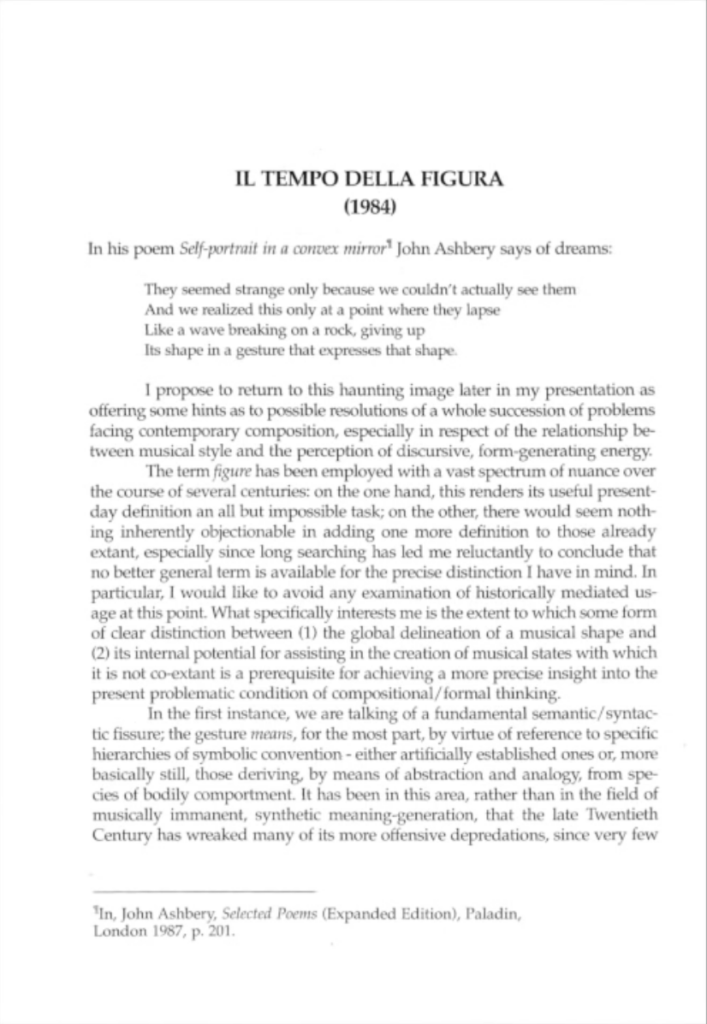First part here. Second part here.
I had come across Samuel Andreyev‘s YouTube channel while spelunking modern performance videos. I found the video of his analysis of Ferneyhough’s String Trio while working on the first movement of my Symphony No. 1 and its ideas resonated with me. Just recently on Friday 19 Feb, he released an interview he did with Ferneyhough on the previous Wednesday (a week and a half prior). It’s an hour and 40 minutes, so I’ll be taking it in parts while listening to performances of the referenced music when available.
A quote by Ferneyhough starting at ~8:15 and ending at ~9:50:
If we can be led up one path and be pulled ourselves by the ear up another path, I find that fascinating.
…
A thing that when it first appears might seem not so important. Might seem incidental. But if you really parse that and redefine that and package it differently in the space of a few minutes, you find that it becomes something central to the discourse. And you don’t remember that it wasn’t there in the first place.
I have always tried to build into my pieces faulty memory.
We all have memories which define us as people, as individuals. If we were to go back to the time, we usually find it was nothing like we remember it. We’ve accreted ourselves in ways that suit us, and we don’t pay attention anymore to what actually took place.
In music this is one of the aspects of composition that interests me the most.

At some point he talks about his String Quartet No. 2.
~19:00-21:00
Regarding disjunctive vs conjunct notes
The figurations of rhythmic structure I try to use them to embody forth the size of the intervals that are being played.
Another piece that comes to mind is my Adagisimo from 1983
…
The two violins have a spectrum [that they share], but no textural or rhythmic figure actually repeats.
Il Tempo Della Figura (1984) – a nine-page essay he wrote, eventually published in Perspectives of New Music, Vol. 31, No.1 (Winter, 1993), paywalled at Scribd.

Discussing the use and meaning of pitch.
24:00
He moves from unordered set of pitch to ordered set (interviewer “random funneling”) starting pitches are arbitrary, though not in a Cage-ian sense. “Foreground the technique.”
Interviewer: “It sounds like the process is more important than the identity of the pitches that you’re actually using.”
27:00
In the 4th quartet what happened mostly is that I orchestrated the four pitches available to me at that moment in such a way that they would or would not reveal their engenderment. Sometimes it’s just a group of pitches spaced [?] instruments. But sometimes I put them all in one instrument and you can hear the actual figuration that they’re derived from.
String Quartet No. 4 (1989-90), 20:47, recorded by the Arditti Quartet
Here are four videos for each movement. Not sure who the performers are. Timings are:
- 3:02
- 5:50 (with soprano)
- Section A
- Section B
- Section C Inquieto
- Section D Larghissimo
- Section E Piacevole
- Section F Luminescente
- Section G Piu animato e mutabile
- Section H Rigorosamente in tempo
- 3:25
- 8:54 (with soprano)
It’s an accessible work with some emotional (is that possible?!) content. Score is scarier than the aural intent.
Quirl – (after the interviewer gets corrected on a specific movement of a specific work) five semitones varied in the “order in which they’re played”.
You hear very much an attraction or repulsion of notes to their engendering figure. [like iron filings on a magnet]
(There is very much in these processes an absence of composer which is very Cage-ian.)
“I’m not a Maxwell Davies” in that there are no historical references. (he references his work Umbrations).
~32:00
Pause even though he continues to discuss compositional characteristics of the Umbrations cycle.